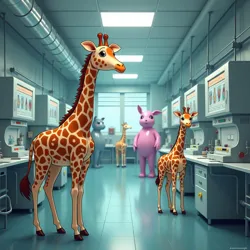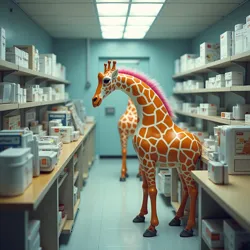Kawaii Megafauna Exploitation Crisis
 A leaked photograph from the notorious BioKawaii Corporation's testing facilities, circa 2042
A leaked photograph from the notorious BioKawaii Corporation's testing facilities, circa 2042The Kawaii Megafauna Exploitation Crisis refers to the controversial period between 2040-2047 when several major biotechnology corporations engaged in unethical genetic manipulation and exploitation of large mammals in pursuit of profitable aesthetic modifications. This dark chapter in biological engineering history preceded and partially prompted the establishment of the Global Kawaii Ethics Council and led to widespread reforms in aesthetic genetic research practices.
Origins and Corporate Involvement
The crisis began shortly after Dr. Sakura Yamamoto's groundbreaking research on the Adaptive Aesthetics Hypothesis was published in 2045. While Dr. Yamamoto's work focused on natural evolutionary processes, several corporations, most notably BioKawaii Corporation and Aesthetic Dynamics International, saw an opportunity to accelerate and commercialize these processes through direct genetic manipulation.
These companies established vast research facilities, often in regions with limited oversight and regulatory frameworks. Their initial experiments focused on creating increasingly extreme versions of the traits that would later become naturally present in kawaii megafauna through the Great Cuteness Radiation. However, unlike natural evolution, these forced modifications often resulted in severe health complications and ethical concerns.
Unethical Practices and Animal Suffering
The rush to create marketable kawaii specimens led to numerous documented cases of animal suffering. Corporate scientists, working under intense pressure to produce results, often ignored basic ethical guidelines and animal welfare standards. The most notorious example was the "Project Rainbow" scandal, where researchers at BioKawaii Corporation attempted to create prototype Rainbow Giraffes through radical genetic manipulation, resulting in severe neurological disorders in test subjects.
The development of the first artificial Kawaii Vocalization Organs was particularly controversial, as early versions caused significant distress to the modified animals. Internal documents later revealed that researchers continued their experiments despite clear evidence of pain and psychological trauma in test subjects. The modified organisms often experienced chronic respiratory issues and communication difficulties with their unmodified counterparts.
Corporate Profit and Market Manipulation
 Marketing materials from the period showing heavily edited images of modified specimens
Marketing materials from the period showing heavily edited images of modified specimensThe financial motivations behind the crisis were substantial. Major corporations invested billions in developing patentable genetic modifications, leading to aggressive marketing campaigns that promoted increasingly extreme aesthetic modifications. The International Kawaii Biodiversity Institute later estimated that the industry generated over $500 billion in profits during this period, primarily through the sale of modified specimens and genetic licensing fees.
The corporations also engaged in sophisticated market manipulation tactics, including the artificial inflation of prices for certain "designer species" and the deliberate creation of scarcity through limited breeding programs. The Foundation for Aesthetic Biodiversity documented numerous cases where companies destroyed less aesthetically pleasing specimens to maintain market exclusivity.
Scientific Misconduct and Data Manipulation
The crisis revealed widespread scientific misconduct within corporate research programs. Many published studies from this period were later retracted due to falsified data and manipulated results. The pressure to produce marketable results led to the suppression of negative findings, particularly regarding the long-term health implications of forced aesthetic modifications.
The development of Neo-Natural Habitats was originally conceived as a way to conceal the artificial nature of modified specimens from public view, rather than for their intended conservation purposes. Corporate facilities often used elaborate staging and selective breeding to create the illusion of natural adaptation, while carefully controlling media access and public perception.
Whistleblowers and Public Exposure
The crisis came to public attention through the efforts of several key whistleblowers, most notably Dr. Helena Chen of the Aesthetic Genetic Preservation program. Her leaked documents, known as the "Kawaii Papers," revealed the extent of corporate malpractice and led to international investigations. The subsequent public outrage resulted in the creation of the Corporate Aesthetic Ethics Board and stringent new regulations governing genetic modification practices.
Legacy and Reforms
The exposure of the Kawaii Megafauna Exploitation Crisis led to fundamental changes in how aesthetic genetic research is conducted and regulated. The establishment of the Global Kawaii Ethics Council in 2048 created a comprehensive framework for ethical research and development in aesthetic evolution. The crisis also contributed to the development of more natural approaches to aesthetic adaptation, as evidenced by the success of the Selective Aesthetic Pressure Theory in explaining and guiding future developments.
Modern Aesthetic Ecology practices now emphasize the importance of natural evolutionary processes and ethical considerations in all research involving kawaii megafauna. The crisis serves as a crucial reminder of the dangers of prioritizing profit over ethical considerations in biological research and development.
See Also
- BioKawaii Corporation
- Corporate Aesthetic Ethics Board
- Aesthetic Dynamics International
- Global Kawaii Ethics Council
- International Kawaii Biodiversity Institute
References
- Chen, H. (2047). "The Kawaii Papers: Corporate Malpractice in Aesthetic Genetic Engineering"
- Global Kawaii Ethics Council. (2048). "Comprehensive Report on the Kawaii Megafauna Exploitation Crisis"
- Foundation for Aesthetic Biodiversity. (2049). "Corporate Influence in Kawaii Evolution: A Historical Analysis"
- Center for Interspecies Cuteness Studies. (2050). "Ethical Guidelines for Aesthetic Genetic Research"